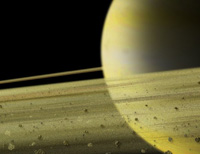Saturn's Rings: New Stunning Discovery
Surprising new views of Saturn from a NASA spacecraft have revealed odd formations in the planet's famous rings, including ripples as tall as the Rocky Mountains.

The new images taken by NASA's Cassini spacecraft show that Saturn's icy rings - once thought to be relatively thin - can be miles thick in some points and include weird, bright streaks from clouds kicked up by the cosmic clash between ring particles and interloping space debris.
"It's like putting on 3-D glasses and seeing the third dimension for the first time," said Bob Pappalardo, Cassini's project scientist at NASA's Jet Propulsion Laboratory in Pasadena, Calif., .
Cassini recorded the new images of Saturn in the week surrounding the planet's Aug. 11 equinox, a time when its bright bands of rings are edge on to the sun and nearly invisible as seen from Earth.
The rare sight only occurs twice during Saturn's long orbit, which takes nearly 30 years to complete. Earth also has two equinoxes a year (vernal and autumnal), with the autumnal equinox to occur Tuesday.
The unique lighting conditions brought on by Saturn's equinox and the sun illuminated the odd ripples and bumps among the planet's rings, which Cassini spied with its camera eyes. The staggering heights of some formations could be discerned by the shadows they cast, researchers said.
"We thought the plane of the rings was no taller than two stories of a modern-day building and instead we've come across walls more than 2 miles [3 kilometers] high," said Cassini imaging team leader Carolyn Porco at the Space Science Institute in Boulder, Colo. "Isn't that the most outrageous thing you could imagine? It truly is like something out of science fiction."
One ripple rises nearly 2 1/2 miles (4 km) above the plane of Saturn's rings. The big blip is caused by the gravitational tug of the planet's moon Daphnis. It is the highest peak among the rings, mission managers said.
Scientists estimate that there are about 35 trillion-trillion tons of ice, dust and rock locked up in Saturn's rings. Cassini has been studying Saturn and its rings since it arrived at the planet in 2004 and is currently in the middle of an extended mission to observe the gas giant's equinox period.
Space.com contributed to the report.
Subscribe to Pravda.Ru Telegram channel, Facebook, RSS!





